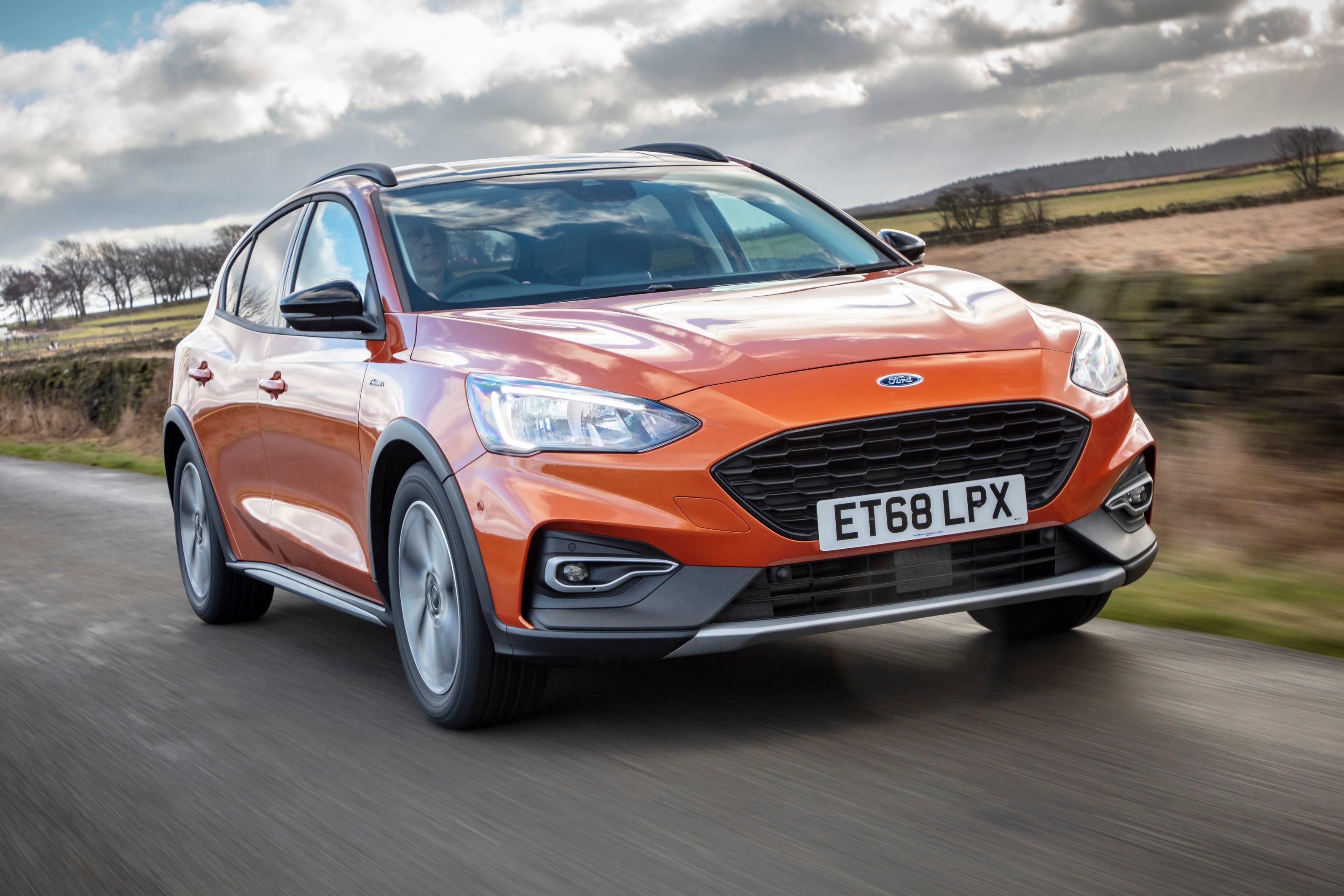Audi A1 Citycarver (2019-2021) Review
Written by Andrew Brady
Quick overview
Pros
- Extra ride height gives driver good all-round view
- Decent space in the rear seats
- High level of standard equipment
Cons
- Some cabin materials not as solid as we’d like
- Smaller engine needs worked hard on motorway
- Expensive next to key rivals
Overall review on the 2019-2021 Audi A1 Citycarver
"Audi hasn’t strayed too far from its A1 Sportback model to create the Citycarver. This is generally a positive move as the Citycarver’s opposition is also supermini-based in the shapes of the Ford Fiesta Active, BMW X1 and Renault Captur, although those latter two are more dedicated in their styling to distinguish them from their parentage."
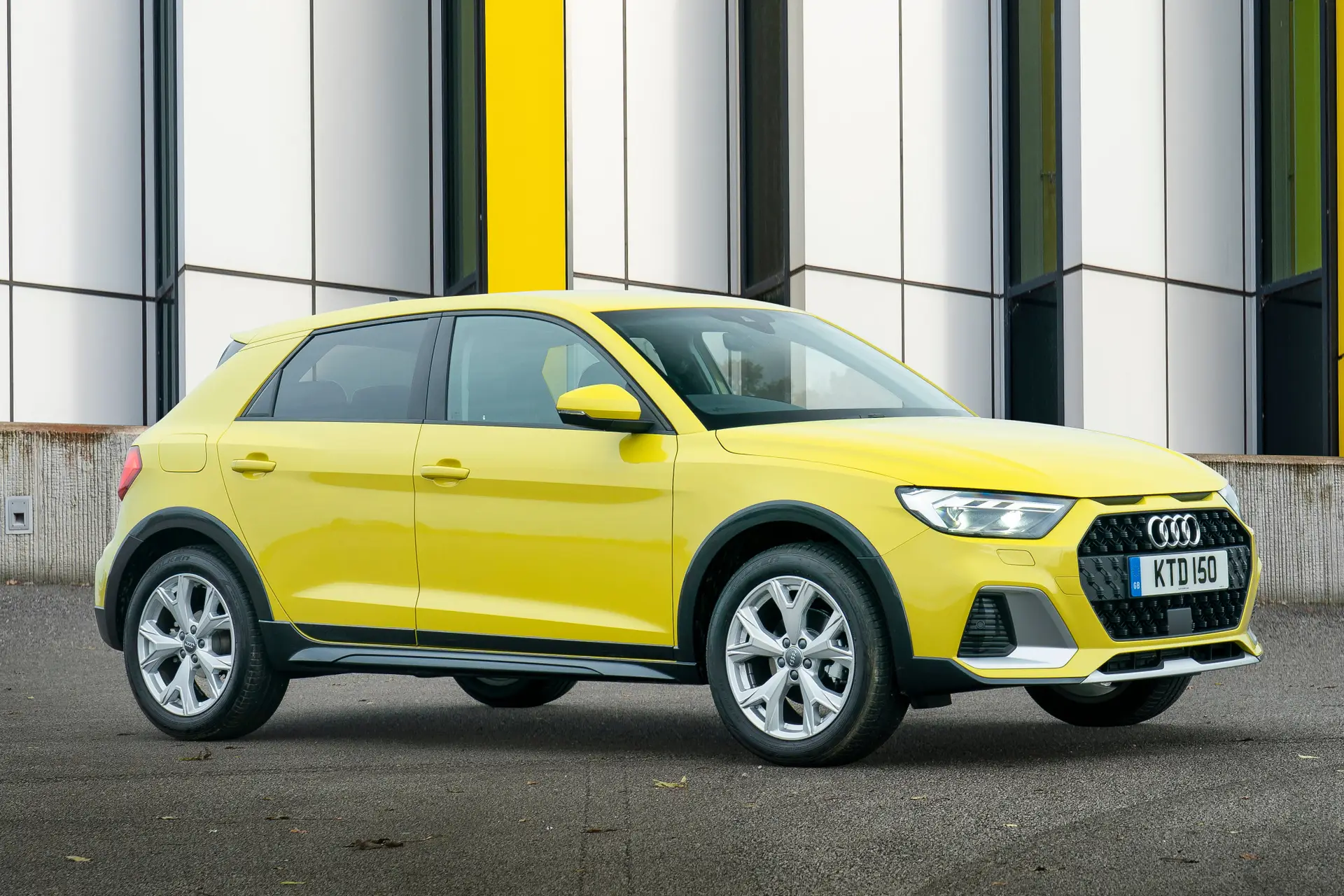
For the Audi A1 Citycarver 2019-2021 review, we look at how Audi has chosen to set it apart from the Audi A1 with a 4cm raised ride height and some styling nods borrowed from its Q models. Don’t be fooled into thinking this is an off-roader or even a small SUV with some moderate muddy lane abilities. It’s not. The Audi A1 Citycarver is very definitely a supermini at its core and, as the name suggests, is a car meant to deal with the urban jungle rather than the wilds of Borneo.
Even so, it comes with the obligatory underbody tray to give the impression of some added protection if you were to head off the beaten trail. The big octagonal front grille is also similar to the Audi Q3’s, while at the back there’s also a ruftier, tuftier bumper compared the Sportback.
Inside, any pretensions the Citycarver is anything but an Audi A1 on stilts is abandoned as the cabin is identical other than the higher ride height affording a better all-round view for the driver. That’s a good thing in our book and makes the Citycarver a little better suited to dealing with congested town roads than its sister A1 Sportback model.
In the cabin, you get the same 10.25-inch Digital Cockpit dash display and 8.8-inch infotainment screen. Not only does this look good to the eye, it’s easy to use and makes the Citycarver one of the more advanced cars in its niche for this kind of tech.
As far as space and practicality go, the Citycarver is exactly the same as the A1 Sportback, so you get plenty of room up front and decent space in the back for two adults or three kids. The boot is also a generous size and easily expanded by folding the split and tip rear bench.
Where the Citycarver does depart from the A1 Sportback script is in the way it deals with bumpy roads. Where most A1 Sportback models are blighted by suspension that is too firm, the extra height of the Citycarver means the firm-ish suspension does a fine job of containing body lean without feeling too brittle or jarring over the usual collection of hillocks and ruts that make up many roads.
On top of decent handling and so-so refinement, the Citycarver is offered with a pair of turbo petrol engines. The 30 TFSI uses a 1.0-litre three-cylinder motor with 116PS that’s fine in town but needs to be worked a little harder than you might expect on faster roads.
For this reason, we’d err more towards the 35 TFSI with its 150PS engine. Both can be ordered with either a six-speed manual or seven ratio S tronic automatic gearbox that are smooth and easy to use. This completes the A1 Citycarver’s package as a more rounded, but also more expensive, alternative to the Audi A1 Sportback.
Is the 2019-2021 Audi A1 Citycarver right for you?
Style conscious urbanites will love the Audi A1 Citycarver. After all, it has the mildly rugged feel of an SUV in a car that is compact enough to bung into any parking spot with ease. It also offers more ground clearance to waft over speed bumps and the suspension is more absorbent than the A1 Sportback’s.
You will have to be willing to a pay extra for the Citycarver’s charmed over the A1 Sportback, though. For that, however, you get a very well equipped compact crossover that comes with a classy Digital Cockpit dash display and central infotainment screen that sets it apart from most rivals.
Covering the basics, the Citycarver has plenty of space for front and rear passengers, a well-shaped and sized boot, and turbo petrol engines with low running costs. For picking the kids up or heading off for the weekend, the A1 Citycarver can cope.
What’s the best Audi A1 Citycarver model/engine to choose?
There’s a choice of two turbo petrol engines, starting with the 30 TFSI that comes with 116PS and a choice of six-speed manual or seven gear automatic gearboxes. For most drivers, this will be ideal in town and for the occasional jaunt to see Aunty Nellie down in the country thanks to good fuel economy, and the generous levels of standard equipment in the one-trim-only A1 Citycarver.
However, if you’re piggy bank is feeling sufficiently fattened, we’d say to opt for the 35 TFSI version with its 1.5-litre turbo petrol engine. Its 150PS makes all the difference when accelerating away from the traffic lights in a hurry or cruising on the motorway. Like the 30 TFSI, it comes with a choice of manual or auto transmissions, and we’d have the light and easy manual for its greater involvement and marginally better fuel efficiency.
What other cars are similar to the Audi A1 Citycarver?
The Ford Fiesta Active is closest in approach to the Audi A1 Citycarver as it builds on the base supermini with added ride height and some faux off-road body add-ons. You get a wider choice of trims and engine options with the Ford, but the Audi wins out for premium appeal.
The Nissan Juke and Renault Captur are more overtly styled as compact crossovers and both deliver similar driving experiences and levels of practicality. Like the Ford, they give buyers more say in the trim levels and engine options, but neither has the draw of that Audi badge.
Comfort and design: Audi A1 Citycarver interior
"The A1 Citycarver’s raised ride height gives the driver a noticeably better view out of the road ahead. This gives that all-important sense of security that draws many to SUVs and crossovers, so it’s a thumbs up here for the Audi."
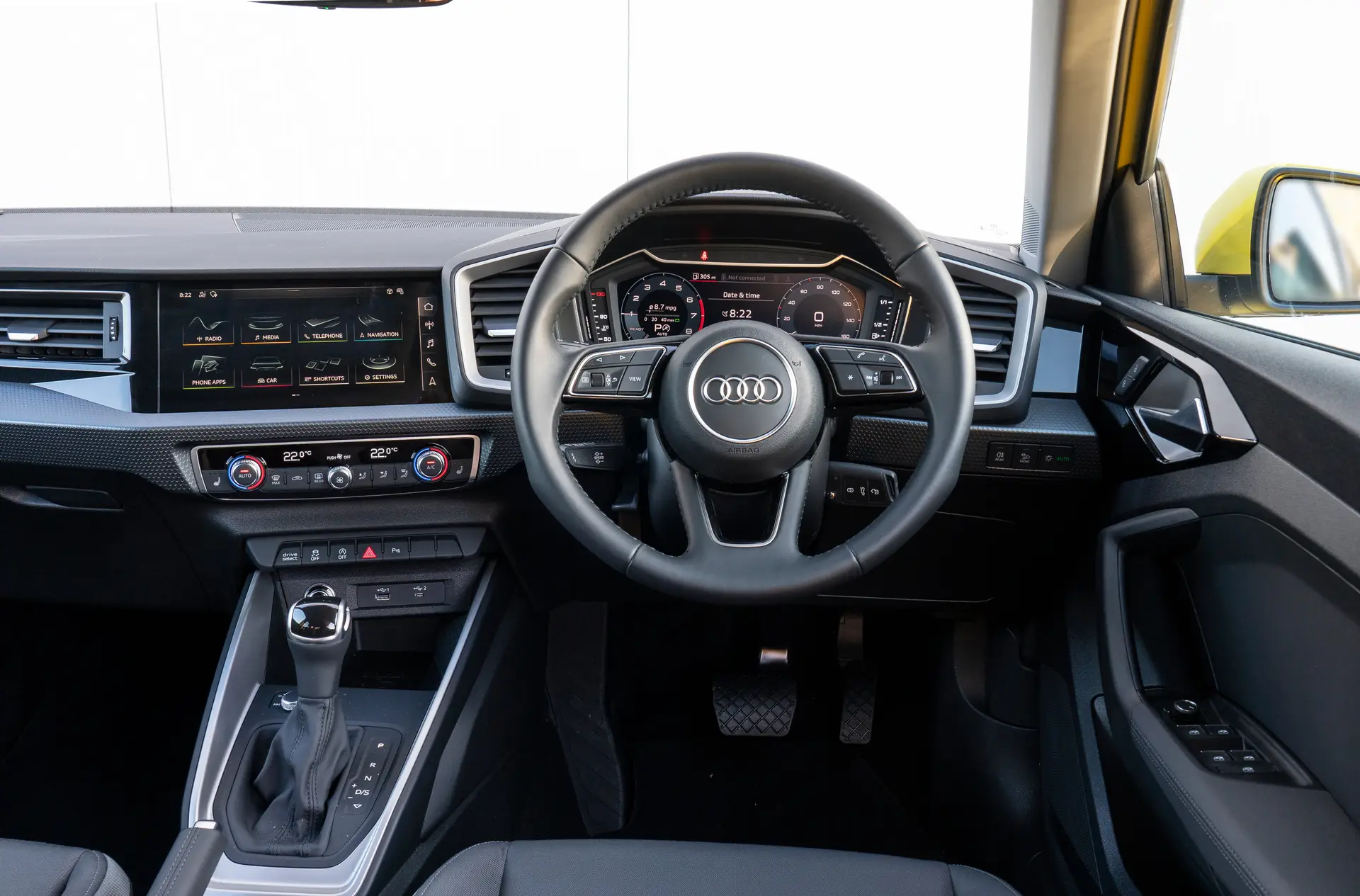
It’s also a big merit point for the driving position thanks a seat with height adjustment as standard and a steering wheel that can be altered for reach and depth. Together, they alloy for excellent comfort. Our only criticism is the thick rear pillars between the back doors and tailgate limit over-the-shoulder vision for the driver when swapping lanes or reversing into a parking space.
The main dash has a jagged sweep across the width of the car. In front of the passenger is a broad air vent, while the rest of the dash angles in towards the driver. This puts the infotainment screen close by when you need to press a button on the display. Thankfully, these buttons are big and respond quickly to a prod.
The rest of the controls are positioned with Audi’s usual close attention to ergonomics. Perhaps more unusual is a manual handbrake in the Audi A1 Citycarver rather than the electric type more often used in premium models nowadays. Still, it works well and doesn’t get in the way when using the manual gear shifter.
Longer trips are made easy by the comfortable seats. Quicker versions like the Competition and Vorsprung have sports front seats, which look good but eat into rear legroom.
Quality and finish
Strangely for Audi, the fit and finish of the Audi A1 Citycarver is a not as classily perfect as we’re used to from this company. At first, everything seems right with the world as your hands are met by soft-touch plastics and high-grade materials.
However, more time spent in the Citycarver reveals some of the plastics that are not immediately obvious have been pared back. For example, the door panels feel quite cheap and not what we’d expect of an Audi or a premium supermini with matching price tags. Even so, the Citycarver’s cabin feels robustly built, so we don’t expect any rattles to develop.
The Citycarver comes in its own unique single specification, unlike the A1 Sportback that is offered in a variety of trims. With the Citycarver, you get Novum cloth sports seats with a hexagonal check that adds a welcome point of differentiation to the Sportback. Choose the Plus Pack and you gain climate control, rear privacy glass and an adjustable armrest between the front seats.
Infotainment: Touchscreen, USB, nav and stereo in the Audi A1 Citycarver
The Audi A1 Citycarver comes with the 10.25-inch Digital Cockpit display that presents the main instruments’ information in a digital cluster and can be altered to show speed and revs more or less prominently. It can also show details on gear selection, time, radio and the telephone menu.
You also get the an 8.8-inch touchscreen to operate the infotainment. The colour screen can connect to your smartphone using Bluetooth or a USB port to access music, phone calls, sat-nav and other apps all worked through the display at the touch of a finger.
An option for the Citycarver is the Technology Pack for £1695. It brings a larger 10.1-inch infotainment screen with sat-nav and 3D city display to make it easier to identify where you are on the map. There is also voice and handwriting recognition to make it faster to input a destination. Another part of this pack is you can put the nav display into the main dial’s screen and it comes with a three-year subscription to Audi Connect Infotainment Services (MMI) for internet access.
Space and practicality: Audi A1 Citycarver boot space
The Audi A1 Citycarver may be a car aimed at stylish young blades about town, but it will also have to work for its living as family transport. This is where it has to be as versatile and practical as rivals such as the Ford Fiesta Active, BMW X1 and MINI Countryman.
Audi’s determination to get on terms with these rivals is clear in the rear seats where adults can reside in reasonable comfort just as they can in the Audi A1 Sportback. There’s reasonable headroom for most adults back here and enough elbow and leg room for comfortable travel on short to medium trips. For longer journeys, the rear seats are best held back for the kids.
There’s a trio of three-point seat belts in the back too, plus a pair of ISOFIX child seat mounts. The middle seat belt is an ambitious thought for adults but makes the A1 able to carry your kids plus a mate safely. Big door bins will stash all their sweetie wrappers, but that’s it for storage in the hind quarters.
If you need to carry luggage, the Audi A1 Citycarver’s boot offers 335-litres of space, which puts it about average for the class. Fold down the 60/40 split and tumble rear seat back and you can access up to 1090-litres of cargo carrying clout through the tailgate opening. The load floor is flat and under the cover resides a get-you-home puncture repair kit in lieu of a spare wheel.
Move forward in the cabin and the two front occupants have plenty of space to stretch out. Each front seat has manual height adjustment and the driver can further hone the seating position with reach and angle movement for the steering wheel. Door bins, glovebox and a tray in front of the gear lever take care of storage.
The instruments and infotainment are easy to read and can be used most of the time through the steering wheel buttons. Audi also deserves praise for the oh-so simple rotary controls for the heat and fan settings. No need to look at the digital read-outs for these, just twist the dial to make the cabin warmer or cooler.
As to be expected, the Citycarver is slightly bigger than the standard A1 at 4044mm long, 1940mm wide and 1483mm tall.
Handling and ride quality: What is the Audi A1 Citycarver like to drive?
"Where the A1 Sportback is divided into two camps by its suspension that is either just about okay or too firm in models equipped with the Sports option, the Citycarver is a much better resolved car. Its suspension adds 4cm to the ground clearance of this A1 and it makes a huge difference to how this car copes with bump-battered roads."
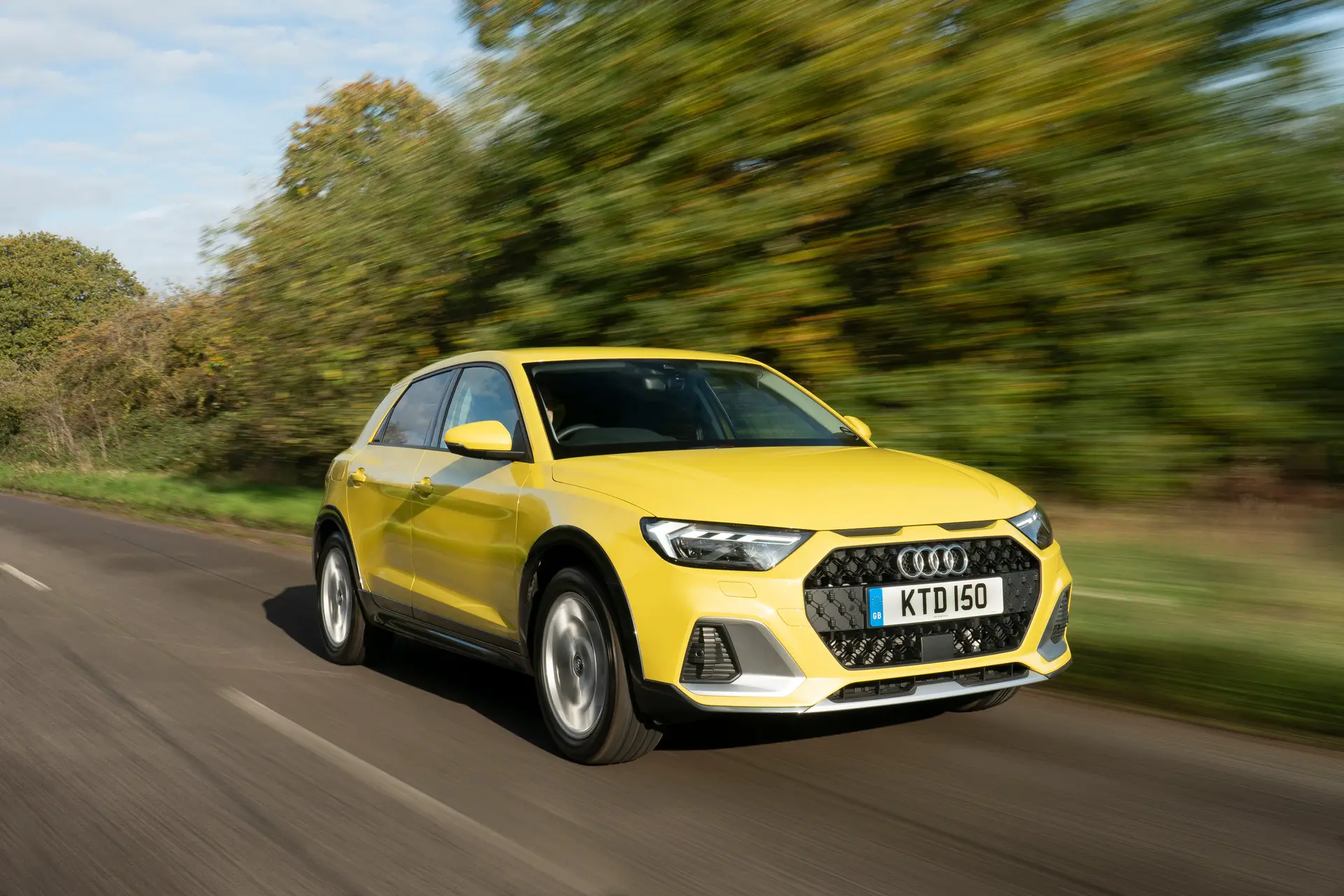
It’s no off-roader, but the Audi A1 Citycarver does make a sound job of picking its way along most street and roads without the underlying crashy firmness in the Sportback. There’s enough stiffness present to stop the car flopping about as you change direction and head through corners, but it also has sufficient absorbency to keep most of what’s happening under the wheels filtered out from the cabin.
This makes the Citycarver a more comfortable car to travel in than the Audi A1 Sportback on 16-inch wheels even though the Citycarver comes with 17-inch alloy wheels as standard. It makes us wonder why Audi cannot apply this thinking to the rest of the A1 range’s suspension set-up?
Aside from this, the Audi A1 Citycarver is competent and capable when it comes to dealing with corners on faster roads. The steering responds quickly to the driver’s commands, though it does not have the same touchy-feeling interaction that you get with a BMW or MINI. Even so, it’s light to twirl the steering wheel when parking and the Citycarver’s relatively compact dimensions make it easy to nip into parking spaces. Only the thick rear pillars hinder this slightly, but you do get standard rear parking sensors to warn of impending threats to the bodywork.
One other point to bear in mind with the Audi Citycarver is it is resolutely a front-wheel drive car, not all-wheel drive. So, don’t expect it to cope any better with slippery or snowy conditions than the A1 Sportback.
What engines and gearboxes are available in the Audi A1 Citycarver?
Those choosing the Audi A1 Citycarver, you have two simple decisions to make when picking this car. First is the engine and second is the gearbox.
We’ll start with the engines and the 30 TFSI model’s 1.0-litre turbo petrol motor that serves up 116PS. It’s not a huge amount of power but is enough to make easy work of driving in town and further afield into the wider world. However, if you spend a lot of time on motorways, this engine needs to be worked quite hard to deliver what feels like a decent turn of acceleration up to highway speeds.
This is why we reckon it’s wise to spend the extra on the 35 TFSI engine. It’s another turbo petrol unit but this 1.5-litre motor provides 150PS to have a much broader spread of power and talents. It’s happy to work hard when you need to get a shift on, yet it’s also more relaxed when you want to cruise at higher speeds.
Then you have to decide between the two gearbox options. The first is the manual six-speed transmission and it’s the one that gets our vote. It has a light, well defined action and makes either A1 Citycarver feel slightly zippier than their counterparts with the seven-speed S tronic dual-clutch auto ’box alternative. If you do want or need to go down the automatic route, the S tronic changes gear smoothly, if not as briskly as we’d like much of the time, it’s certainly among the best in this sector.
Refinement and noise levels
Audi may have addressed the ride quality issues of the Audi A1 Sportback in the Audi A1 Citycarver, but it has not dealt with refinement quite as thoroughly. On most roads, there is still a discernible whirring noise from the tyres as they pass along the surface and it makes itself to audible in the cabin.
This background hum of road noise is not too intrusive in town unless the road has a particularly coarse grain or badly needs to be re-laid. However, head on to faster routes and the noise increases in line with the rate of travel.
Thankfully, the Audi A1 Citycarver does a far better job of keeping wind and engine noise from entering the cabin to any great volume. Even on the motorway, whistling from the wind around the windscreen and door mirrors is lower than you’ll find in most compact crossovers. This is further assisted by the Citycarver doing without roof rails as standard where some competitors include them to complete the SUV look.
Both engines are commendably hushed at all speeds, even when they are pressed hard to give good acceleration. We also like the consistent feel of the pedals when they are depressed, adding to the premium sensation of driving the A1 Citycarver.
Safety equipment: How safe is the Audi A1 Citycarver?
Pick the Audi A1 Citycarver and you’ll have twin front, side and curtain airbags to protect the car’s occupants. It also has ESP stability control and a hill hold assist to prevent the car from rolling backwards as you let off the handbrake on inclines.
All of this has helped the A1 Citycarver achieve a very high 95% score for adult occupant safety and 85% rating for child safety in Euro NCAP crash tests. The Audi also manages 80% for safety assist systems. They include a lane departure warning that alerts the driver if the car begins to wander across a road marking. Should the driver lose concentration on what is ahead, the emergency city braking system will apply the brakes if you don’t and, in the event of a collision, it will even contact the emergency services itself.
More standard kit comes with twin rear ISOFIX child seat mounts and rear parking sensors. You can add to the car’s safety kit with options such as a rear parking camera, parking assist, adaptive cruise control and automatic high beam assist to guard against dazzling oncoming cars.
Another option for the Audi A1 Citycarver is an integrated dash cam called Universal traffic recorder. You can pick between a single front-facing camera or one with front and rear cameras for full coverage.
MPG and fuel costs: What does an Audi A1 Citycarver cost to run?
"It will come as little surprise to learn the most efficient engine in the A1 Citycarver range is the 1.0-litre motor in the 30 TFSI model. With the six-speed manual gearbox it delivers 45.6mpg combined economy, which equates to 400 miles on a full tank when cruising on the motorway."
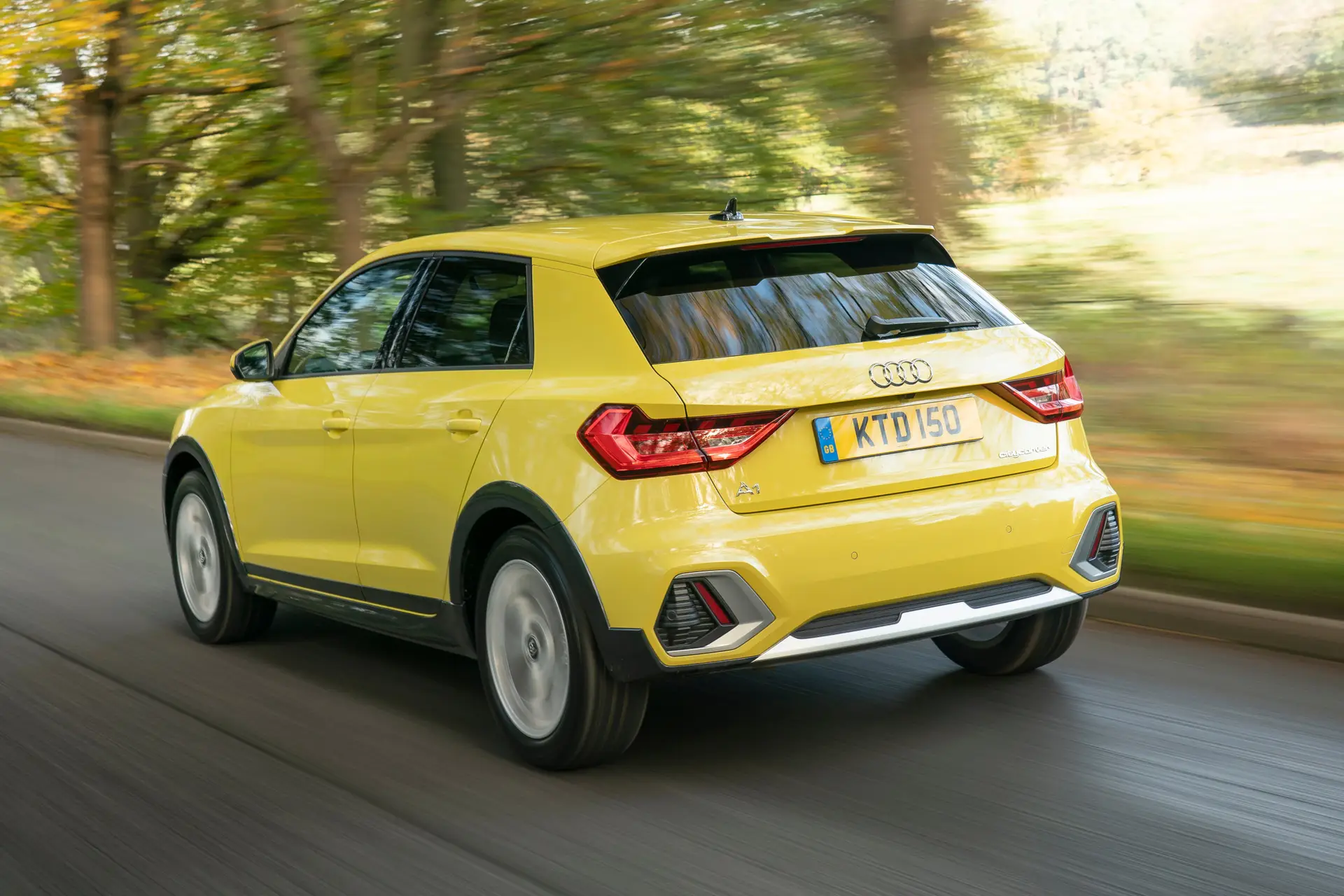
The 30 TFSI with the S tronic automatic gearbox offers 43.5mpg, which is the same as the 35 TFSI S tronic model. Choose the bigger 1.5-litre engine of the 35 TFSI with the six-speed manual and it returns an average consumption of 44.8mpg.
How reliable is the Audi A1 Citycarver?
Audi placed 21st out of 30 manufacturers in the latest HonestJohn.co.uk Satisfaction Index with a score of 86.9% satisfaction. However, the A1 Sportback does have a good reputation for reliability and the Citycarver should be no different.
Insurance groups and costs
Choosing the Audi A1 Citycarver over the Audi A1 Sportback model in an equivalent spec and with the same engine will not cost you anything more when it comes to paying for insurance. The 30 TFSI Citycarver sits in the same group 16 insurance bracket as the Sportback.
Opt for the A1 Citycarver with the 35 TFSI engine and it could be slightly cheaper to get cover for as this model sits in group 24 compared to group 25 for some of the higher trim levels of Sportback with the same motor and gearbox.
VED car tax: What is the annual road tax on an Audi A1 Citycarver?
The raised ride height of the Citycarver and its standard 17-inch wheels impact on its carbon dioxide emissions compared to the Audi A1 Sportback. This is clear when then Citycarver in 30 TFSI form sits in the £215 band for first year road tax regardless of whether you choose the manual with 140g/km or automatic gearbox that emits 147g/km.
Take the 35 TFSI with its larger 1.5-litre engine and its emissions rise to 143g/km for the manual, but are fractionally lower for the S tronic auto at 146g/km than the 30 TFSI’s. However, you’ll still be paying £215 in the first year for road tax and £150 each year after that.
How much should you be paying for a used Audi A1 Citycarver?
"Search through the ads and you can find two-year old A1 Citycarvers with the 30 TFSI engine out there from £22,000. These cars have only around 20,000 miles on the clock. Expect to pay another £2000 on top of this for an S tronic version."
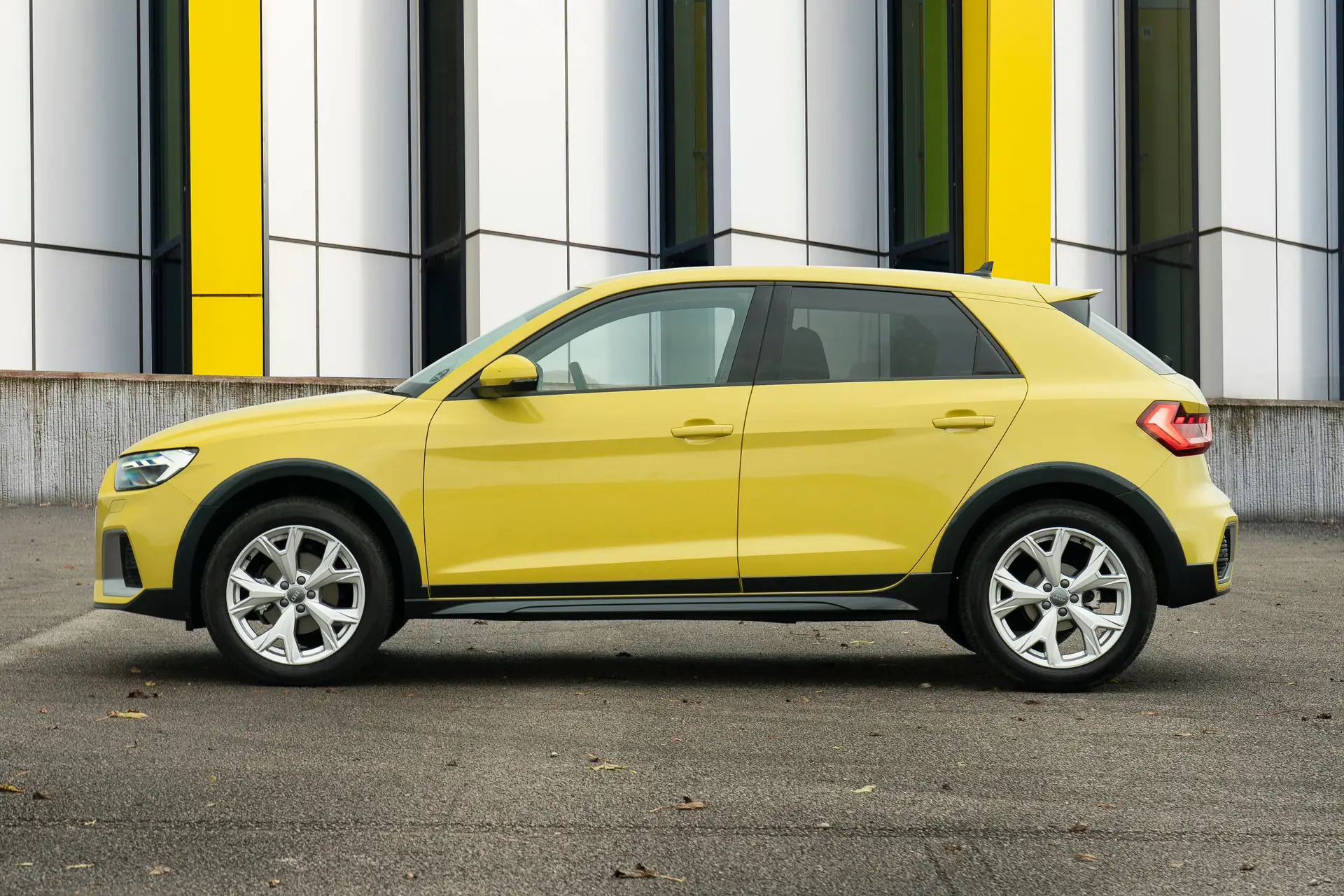
If you want the larger 35 TFSI engine, you’ll be looking to spend from £23,000 for a manual car and, again, a further £1000 to drive away in one with the S-tronic automatic gearbox. Cars with desirable extras such as the Technology Pack will also come with an additional premium.
Trim levels and standard equipment
Audi offers the Audi A1 Citycarver in its own single, well equipped specification. It sits on 17-inch alloy wheels, while the body has black plastic cladding around the wheelarches and unique bumpers with underbody protection.
The suspension sits 4cm higher than an Audi A1 Sportback and you get Audi Drive Select as standard with the A1 Citycarver, providing Auto, Dynamic, Efficiency and Individual modes. There are LED lights with dynamic rear indicators, and a rear roof spoiler.
Sports front seats are included and there’s Novum cloth upholstery all round, as well as electric windows front and rear. The driver has a 10.25-inch Digital Cockpit dash display and 8.8-inch infotainment touchscreen with Audi Smartphone interface to access phone apps. It also has voice control, Bluetooth connection and DAB radio.
Safety is taken care of with Audi’s Pre-Sense emergency braking, Hill-hold assist for the handbrake, and Lane departure warning. You also benefit from cruise control, rear parking sensors and a speed limiter that can be pre-set.
Ask the heycar experts: common questions
Whats the difference between Audi A1 and A1 Citycarver?
Does the Audi A1 Citycarver come with All-Wheel Drive?
Has the Audi A1 Citycarver been discontinued?
Stay up to speed with great offers plus the latest car news and reviews
Keep me updated by email with the latest advice, news and offers from heycar.
By submitting you agree to our privacy policy

